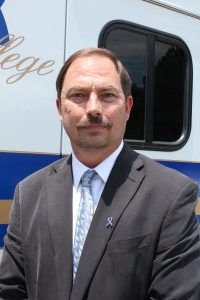By Leischen Stelter, editor of In Public Safety
Most of what the average person knows about fire safety likely came from his or her early education and involved characters like Smokey Bear and Sparky the Fire Dog. While these programs have proved very effective at increasing fire safety awareness for entire households, education efforts should not end at middle school.

Veteran firefighter and longtime educator Dr. Kevin Kupietz believes that college students are a prime target for disaster preparedness education. As part of his enrollment in the U.S. Fire Administration (USFA) Executive Fire Officer Program, Kupietz conducted a mixed-methods research project focused on the feasibility of incorporating prevention and disaster preparedness information into general-core college classes.
“Imagine a world population that understands the value of being prepared for a disaster and is properly equipped to help themselves as well as their neighbors in time of need,” he said. It is possible, but requires new approaches to education and buy-in from local firefighters and educators.
[Related: Firefighters Protect and Educate Communities]
Information about prevention and emergency preparedness itself is relatively simple and straightforward. The main issue, which was the focus of his study, is determining the most effective way to deliver this information to older students.
Delivering Disaster Preparedness Information via Core Courses
Educators know that there is a lot of value in making information relevant to a student’s experience and that students learn best when they are focused on a situation, not just a subject. Based on this knowledge, Kupietz proposed that professors incorporate disaster preparedness information indirectly into assignments so that students who are learning core curriculum get information with relevance to their lives at the same time.
For example, following a major storm, a math teacher could ask students to calculate how much water, food and medication the Federal Emergency Management Agency (FEMA) recommends an individual have on hand. This problem not only requires students to perform mathematical calculations, but the results offer important information about emergency and disaster preparedness. The situation presented in the assignment is directly tied to students’ recent experience, which makes it relevant and increases the likelihood that they will retain the information.
Construction of the Research Project
In order to determine whether his idea was feasible in the college setting, Kupietz collected and analyzed data from three different groups of people:
Firefighting Community
Kupietz surveyed fire professionals who were members of the National Society of Executive Fire Officers (NSEFO), which consists of well-educated and experienced firefighters from across the country. He chose this group because they are likely to know about education methods being used by the fire service and are diverse in age, geography, rank, department size, etc.
These firefighters were asked if they purposefully target college students in their prevention programs. Results showed that only 5.6% say they target college students and only 41.7% say they conduct training for college students upon request.
Academic Community
Kupietz also conducted a focus group of college professors and asked them whether they would be willing and able to provide assignments that meet the set class objective while subtly introducing preparedness information as well. The results showed that this group believes it is both feasible and desirable.
Professors noted that students often complain that the information being taught is not relevant to their lives. Therefore, the majority of professors responded to the research saying that having material that students could identify with would be better learned and retained and would hopefully contribute to positive changes in students’ behavior.
Student Groups
Kupietz conducted a quasi-experiment in which he incorporated preparedness information into a developmental math class and tested different groups of students (three test groups and one control group).
He gave the groups three different homework assignments. One included 10 math problems regarding fire sprinklers that pointed out that sprinklers only go off when activated by heat (not smoke, which is a common misconception). The math problem asked students to calculate water flows from sprinklers affected by heat. The second homework informed students of the FEMA recommendation to have at least three days of prescription medication on hand during a disaster and asked mathematical questions based on this fact. The third assignment referred to the FEMA recommendation to have one gallon of water a day on hand during a disaster for each person in a house and asked students to make calculations based on this fact.
After the assignments, students were not given any more information about preparedness and instructors reviewed the questions only from a math perspective. Several days after the assignment was given, Kupietz conducted a test to evaluate student awareness of these subjects to determine if this education method was effective.
Combining the three experimental groups together, 87% of students correctly answered the question about the material that they had been indirectly exposed to. As expected, the control group who had not been exposed to any of the homework assignments scored very poorly on the survey.
Future Application
The research shows that prevention and disaster preparedness information can be incorporated into college classes and not interfere with the information being taught, but rather enhances the relevance and applicability of the information for students. While this was done at Halifax Community College in North Carolina, Kupietz believes it can be replicated at colleges across the country. He also believes that pursuing such educational avenues has the potential to save not only lives, but also save millions of dollars in emergency recovery budgets.
“Prevention does not result in the medals and awards that a response rescue does, but it will save more lives every day of the week,” he said.

Comments are closed.